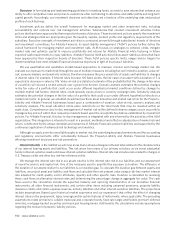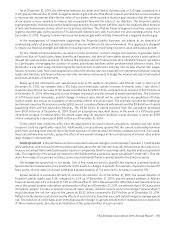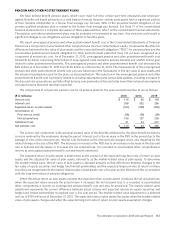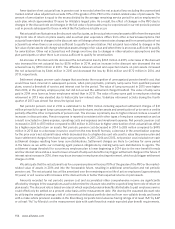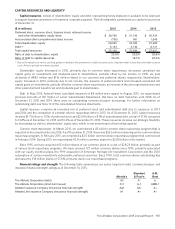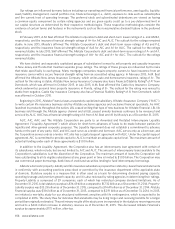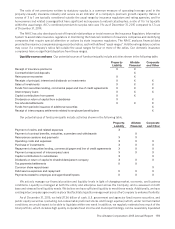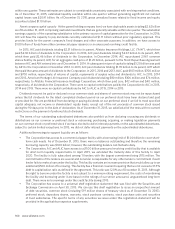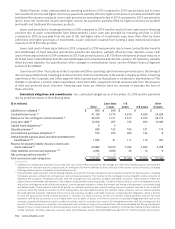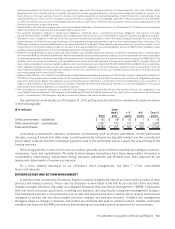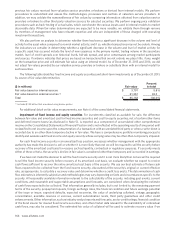Allstate 2015 Annual Report Download - page 165
Download and view the complete annual report
Please find page 165 of the 2015 Allstate annual report below. You can navigate through the pages in the report by either clicking on the pages listed below, or by using the keyword search tool below to find specific information within the annual report.
The Allstate Corporation 2015 Annual Report 159
The ratio of net premiums written to statutory surplus is a common measure of operating leverage used in the
property-casualty insurance industry and serves as an indicator of a company’s premium growth capacity. Ratios in
excess of 3 to 1 are typically considered outside the usual range by insurance regulators and rating agencies, and for
homeowners and related coverages that have significant net exposure to natural catastrophes, a ratio of 1 to 1 is typically
within the usual range. AIC’s combined premium to surplus ratio was 1.9x as of December 31, 2015 compared to 1.7x as
of December 31, 2014.
The NAIC has also developed a set of financial relationships or tests known as the Insurance Regulatory Information
System to assist state insurance regulators in monitoring the financial condition of insurance companies and identifying
companies that require special attention or actions by state insurance regulators. The NAIC analyzes financial data
provided by insurance companies using prescribed ratios, each with defined “usual ranges”. Additional regulatory scrutiny
may occur if a company’s ratios fall outside the usual ranges for four or more of the ratios. Our domestic insurance
companies have no significant departure from these ranges.
Liquidity sources and uses Our potential sources of funds principally include activities shown in the following table.
Property-
Liability
Allstate
Financial
Corporate
and Other
Receipt of insurance premiums X X
Contractholder fund deposits X
Reinsurance recoveries X X
Receipts of principal, interest and dividends on investments X X X
Sales of investments X X X
Funds from securities lending, commercial paper and line of credit agreements X X X
Intercompany loans X X X
Capital contributions from parent X X
Dividends or return of capital from subsidiaries X X
Tax refunds/settlements X X X
Funds from periodic issuance of additional securities X
Receipt of intercompany settlements related to employee benefit plans X
Our potential uses of funds principally include activities shown in the following table.
Property-
Liability
Allstate
Financial
Corporate
and Other
Payment of claims and related expenses X
Payment of contract benefits, maturities, surrenders and withdrawals X
Reinsurance cessions and payments X X
Operating costs and expenses X X X
Purchase of investments X X X
Repayment of securities lending, commercial paper and line of credit agreements X X X
Payment or repayment of intercompany loans X X X
Capital contributions to subsidiaries X X
Dividends or return of capital to shareholders/parent company X X X
Tax payments/settlements X X
Common share repurchases X
Debt service expenses and repayment X X X
Payments related to employee and agent benefit plans X X X
We actively manage our financial position and liquidity levels in light of changing market, economic, and business
conditions. Liquidity is managed at both the entity and enterprise level across the Company, and is assessed on both
base and stressed level liquidity needs. We believe we have sufficient liquidity to meet these needs. Additionally, we have
existing intercompany agreements in place that facilitate liquidity management across the Company to enhance flexibility.
As of December 31, 2015, we held $7.56 billion of cash, U.S. government and agencies fixed income securities, and
public equity securities (excluding non-redeemable preferred stocks and foreign equities) which, under normal market
conditions, we would expect to be able to liquidate within one week. In addition, we regularly estimate how much of the
total portfolio, which includes high quality corporate fixed income and municipal holdings, can be reasonably liquidated



